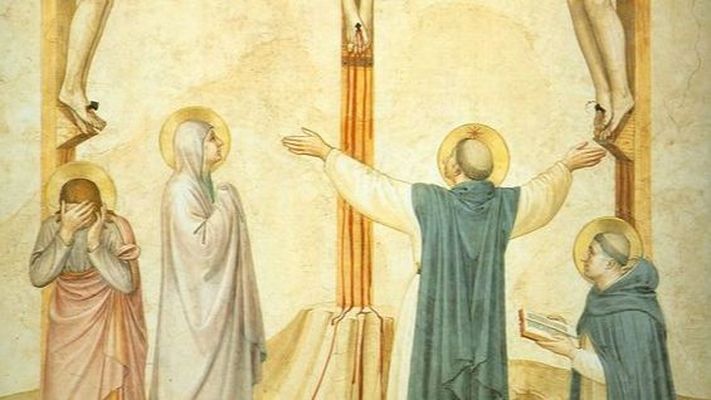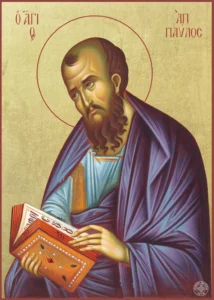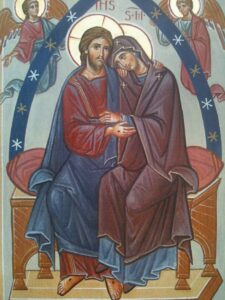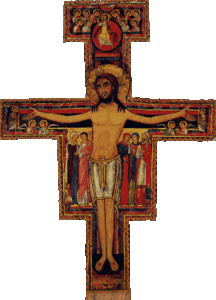Fr. Christopher Etheridge, IVE
Stabat Mater Series: First Week of Lent
Stabat Mater Series: First Week of Lent
I preface this short reflection by saying, that I have decided to focus my Wednesday homilies for the rest of Lent on the Marian hymn, Stabat Mater. I will not be able to get through all the verses, but focusing on a new one each week I hope to use Our Blessed Mother’s example to help us enter the mystery of her Immaculate Heart and it’s intimate union with Christ.The first verse of the hymn reads,
Stabat Mater dolorosa
iuxta Crucem lacrimosa,
dum pendebat Filius.At, the Cross her station keeping,
stood the mournful Mother weeping,
close to Jesus to the last.
Stabat Mater dolorosa
iuxta Crucem lacrimosa,
dum pendebat Filius.At, the Cross her station keeping,
stood the mournful Mother weeping,
close to Jesus to the last.
Stabat Mater dolorosaIt is from St. John’s Gospel that we get the detail of the Blessed Mother’s having stood at the foot of the Cross.
Standing by the cross of Jesus were his mother and his mother’s sister, Mary the wife of Clopas, and Mary of Magdala (19:25).
Many stood near the Cross on that first Good Friday, but only one person’s sorrow could draw near to that of Christ’s—Mary’s. To her are often referred the words of Lamentations, “Is there any sorrow like my sorrow?’ (1:12)
Mother Mary, at the foot of the Cross, there is no sorrow like your sorrow. It is the sorrow that only a mother knows—to watch the fruit of her womb, Jesus, die before her very eyes.
And yet, in this sorrowful mystery we find our hope. In her standing at the foot of the Cross, Mary is the steadfast witness,[1] to the secret of new life. Life is not found in escaping suffering, but in espousing it. In a world that sees suffering as the greatest evil, she is the steadfast witness that sin is truly the world’s greatest evil, and that it is only by joining Christ through redemptive suffering that such an evil is conquered. In a world that sees the Cross as something offensive which must be removed, she is the steadfast witness, that only through the Cross can the world be saved.
Let us learn from Mary, the true value of suffering—let us learn to espouse our sufferings to the suffering of Christ who still hangs (pendebat) from the Cross. He is our hope! Ave Crux Spes Unica!
How is it that He “still hangs”? Because His Body, the Church, still suffers—and where the Body suffers, the Head suffers with it. [2] What does this teach us? That as members of the Body, the Church, we are not alone in our sufferings—moral, physical, spiritual, and personal. Christ remains with us, strengthening us; and where He hangs, Mary stands there too.As she did for Jesus, Mary will do for us—standing close to the last.
Standing by the cross of Jesus were his mother and his mother’s sister, Mary the wife of Clopas, and Mary of Magdala (19:25).
Many stood near the Cross on that first Good Friday, but only one person’s sorrow could draw near to that of Christ’s—Mary’s. To her are often referred the words of Lamentations, “Is there any sorrow like my sorrow?’ (1:12)
Mother Mary, at the foot of the Cross, there is no sorrow like your sorrow. It is the sorrow that only a mother knows—to watch the fruit of her womb, Jesus, die before her very eyes.
And yet, in this sorrowful mystery we find our hope. In her standing at the foot of the Cross, Mary is the steadfast witness,[1] to the secret of new life. Life is not found in escaping suffering, but in espousing it. In a world that sees suffering as the greatest evil, she is the steadfast witness that sin is truly the world’s greatest evil, and that it is only by joining Christ through redemptive suffering that such an evil is conquered. In a world that sees the Cross as something offensive which must be removed, she is the steadfast witness, that only through the Cross can the world be saved.
Let us learn from Mary, the true value of suffering—let us learn to espouse our sufferings to the suffering of Christ who still hangs (pendebat) from the Cross. He is our hope! Ave Crux Spes Unica!
How is it that He “still hangs”? Because His Body, the Church, still suffers—and where the Body suffers, the Head suffers with it. [2] What does this teach us? That as members of the Body, the Church, we are not alone in our sufferings—moral, physical, spiritual, and personal. Christ remains with us, strengthening us; and where He hangs, Mary stands there too.As she did for Jesus, Mary will do for us—standing close to the last.
Ave Crux Spes Unica! Ave Maria!
[1] St. John Paul II, Essential Elements in the Church’s Teaching on the Religious Life, 53.
[2] Cf. Acts 9:4
[2] Cf. Acts 9:4






